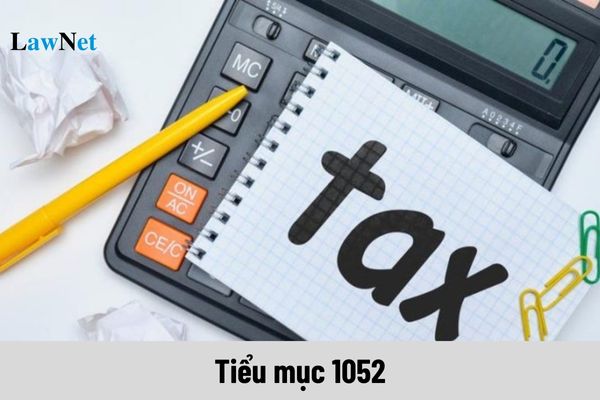What is sub-entry 1052? How to calculate corporate income tax in Vietnam?
What is sub-entry 1052?
According to point b clause 1 Article 4 of Circular 324/2016/TT-BTC, a sub-entry (also known as an economic content code - NDKT) is a detailed classification of an entry used to categorize the revenues and expenditures of the state budget in detail according to the management entities in each entry.
Based on Appendix 3 of the List, the sub-entries issued together with Circular 324/2016/TT-BTC stipulate the corporate income tax sub-entry, including sub-entry 1052 as follows:
| Entry code | Sub-entry code | Description | Notes | |
| entry | 1050 | Corporate Income Tax | ||
| sub-entry | 1052 | Corporate income tax from production and business activities (including services in the oil and gas sector) |

What is sub-entry 1052? How to calculate corporate income tax in Vietnam? (Image from the Internet)
Which entities are corporate income tax payers in Vietnam?
Based on Article 2 of Corporate Income Tax Law 2008 as amended and supplemented by clause 1 Article 1 of the Revised Corporate Income Tax Law 2013, taxpayers are defined as follows:
- Corporate income taxpayers are organizations engaged in the production and trading of goods and services with taxable income as prescribed by this Law (hereinafter referred to as enterprises), including:
+ Enterprises established under Vietnamese law;
+ Enterprises established under foreign law (hereinafter referred to as foreign enterprises) with or without permanent establishments in Vietnam;
+ Organizations established under the Cooperative Law;
+ Public service units established under Vietnamese law;
+ Other organizations engaged in production and business activities with income.
- Enterprises with taxable income as stipulated in Article 3 of the Corporate Income Tax Law 2008 must pay corporate income tax as follows:
+ Enterprises established under Vietnamese law pay tax on taxable income generated in Vietnam and taxable income generated outside Vietnam;
+ Foreign enterprises with permanent establishments in Vietnam pay tax on taxable income generated in Vietnam and taxable income generated outside Vietnam related to the activities of that permanent establishment;
+ Foreign enterprises with permanent establishments in Vietnam pay tax on taxable income generated in Vietnam when this income is unrelated to the activities of the permanent establishment;
+ Foreign enterprises without permanent establishments in Vietnam pay tax on taxable income generated in Vietnam.
- A permanent establishment of a foreign enterprise is a production or business facility through which a foreign enterprise conducts part or all of its production or business activities in Vietnam, including:
+ Branches, executive offices, factories, workshops, means of transportation, oil fields, gas fields, mines, or sites of natural resource exploitation in Vietnam;
+ Construction sites, construction, installation, and assembly projects;
+ Service provision facilities, including consulting services through employees or other organizations and individuals;
+ Agents for foreign enterprises;
+ Representative offices in Vietnam in the case of representatives authorized to sign contracts in the name of the foreign enterprise or representatives not authorized to sign contracts in the name of the foreign enterprise but regularly conduct goods delivery or service provision in Vietnam.
How to calculate corporate income tax in Vietnam?
Based on Article 6 of the Corporate Income Tax Law 2008, and Article 5 of Decree 218/2013/ND-CP, corporate income tax (CIT) is calculated using the following formula:
| CIT = Taxable Income during the Period x Tax Rate |
Where:
(1) Taxable Income:
| Taxable Income = Taxable Revenue - Tax-exempt Income - Losses Carried Forward as per Regulations |
Taxable corporate income is determined as follows:
Taxable Revenue = Revenue - Deductible Expenses + Other Incomes
(2) Corporate Income Tax Rate
Based on Articles 10, 13, and 14 of the Corporate Income Tax Law 2008 and Article 10 of Decree 218/2013/ND-CP, the corporate income tax rate is 20%.
Note: In certain cases where a higher tax rate applies, such as activities in oil and gas exploration and other rare resource extraction in Vietnam, or when preferential tax rates are applied, the payable rate would be lower.
See detailed corporate income tax rates in the Corporate Income Tax Law 2008 and Decree 218/2013/ND-CP.
What is Corporate Income Tax?
Based on Article 3 of the Corporate Income Tax Law 2008 as amended by clause 1 Article 1 of the Law on Amendments to Various Tax Laws 2014, taxable income is stipulated as follows:
Taxable Income
1. Taxable income includes income from production and trading of goods and services and other income as stipulated in clause 2 of this Article.
2. Other income includes: income from capital transfer, transfer of the right to contribute capital; income from real estate transfers, transfer of investment projects, transfer of the right to participate in investment projects, transfer of exploration, mining, and processing rights of minerals; income from property use rights, ownership rights, including income from intellectual property rights as stipulated by law; income from transfer, lease, liquidation of assets, including various securities; income from interest on deposits, loan capital, foreign exchange sales; bad debts recovered after previously being written off; income from liabilities whose creditors cannot be identified; omitted business income from previous years and other income.
Vietnamese enterprises investing abroad that remit their post-local corporate income tax income back to Vietnam, in countries with which Vietnam has a tax treaty, the provisions of the treaty apply; in countries where Vietnam has not signed a tax treaty, if the CIT rate abroad is lower, the difference compared to the CIT under Vietnam’s law is collected.
Thus, corporate income tax is a type of tax that the state directly collects into the state budget, calculated based on taxable income of enterprises (organizations engaged in the production and trading of goods and services).

